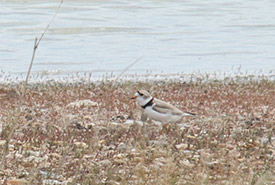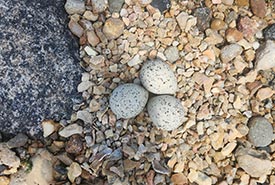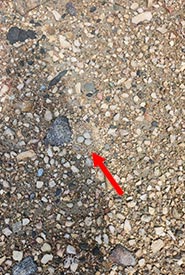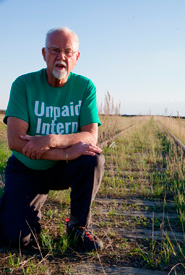Reboot at Shoe Lake: Counting piping plovers

Piping plover at Shoe Lake, SK (Photo by Bill Armstrong)
Revisiting a Nature Conservancy of Canada (NCC) project for a Conservation Volunteers (CV) event is always an interesting experience, for several reasons. It’s an opportunity to renew acquaintances with familiar NCC folk or meet new ones, to meet other volunteers, and, of course, to observe what has changed (or not) on the project. So it was when I participated in a piping plover survey at the Shoe Lake West project south of Moose Jaw, Saskatchewan, in early June that I got to revisit that landscape in nearly five years. This 211-hectare project is located within the Missouri Coteau, an upland area in southern Saskatchewan that features rolling grasslands and wetland habitats.
My first CV event at this location (in 2018) had been to help clean up debris that might be hazardous to wildlife, particularly old fence posts and barbed wire. We had a successful day, easily filling the back of two half-ton trucks, with more to be removed later. That event took place in late August, whereas the piping plover survey occurred in early June in 2023. The appearance of Shoe Lake West was dramatically different. What had been a large saline pothole by late August, was a shallow but large wetland in early June. Water bodies like this usually shrink, sometimes drying up completely over the summer, but Mike Burak, NCC’s program director for Southwest Saskatchewan, said the water level was much higher than it had been over the past year. Precipitation over the winter of 2022-23 was above-average, resulting in a higher-than-usual spring melt. A series of storms that swept over much of southern Saskatchewan in May and early June and brought additional amounts of welcome moisture. The water level was high enough that during our hike we had to make a detour onto higher ground in an adjacent community pasture rather than risk a mucky crossing point. The cows didn’t seem to mind our presence.

Piping plover eggs at Shoe Lake West, SK (Photo by Mike Burak/NCC staff)
Conducting the piping plover survey* involved hiking around the shoreline of a shallow, saline lake that features the right conditions for this endangered bird and other waterfowl: sand, gravel and little vegetation. For convenience’s sake, NCC calls this project Shoe Lake West, but my suggestion is, “Oh-oh, I think I’m about to lose my boot/shoe in this muck” Lake, because what might appear to be a solid shoreline surface can suck you in, figuratively and literally. The important point, though, is that this wetland is attractive habitat for many species of waterfowl and amphibians, including piping plover.

The piping plover nest is well-camouflaged (Photo by Mike Burak/NCC staff)
Our goal during the hike was to try to count the number of individual birds there, and to record any nests. As I was to learn, this is difficult. The birds are small and they move quickly, especially with a group of humans nearby. With individual birds moving about, or gathering in groups as large as six, it was difficult not to duplicate sightings and skew efforts to make an accurate count. Their nests are small, and they are effectively camouflaged to blend in with the surrounding gravel along the shore. As the accompanying photo shows, the piping plover nest that Mike discovered lacked the mix of twigs and mud that I would think of as a “nest.” Once this fact was pointed out, I could see how easy it would be to blunder onto a nest, causing irreparable damage.
The four participating volunteers were retirees: Greg, Shirley, Lynn and myself. The NCC folk included Bohdana, Allyson, Ashley and Mike. During our hike, we observed sanderlings, phalaropes, avocets, marbled godwits and piping plovers, along with many ducks. Clearly, protecting habitat like this is important to the waterfowl that travel through this area, both as a rest stop and as a nesting site.
*Note from NCC: The results of this survey are reported to the Saskatchewan Conservation Data Centre, which is accessible to scientists who may use them for population estimates, modelling, trend analysis, etc. Keeping a close eye on the numbers can help NCC correlate changes in plover abundance (increases or decreases) to factors like climate and weather, or changes to how the project was managed, such that NCC may address any issues.


